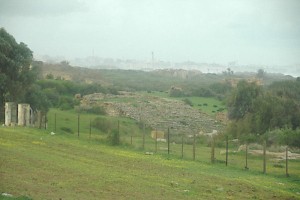Lepcis Magna, Temple of Dolichenus
Lepcis Magna: Phoenician colony, later part of the Carthaginian empire, the kingdom of Massinissa, and the Roman empire. Its most famous son was the emperor Septimius Severus (r.193-211).

The port of Lepcis Magna was visited by sailors from all over the world, and it comes as no surprise that there was a sanctuary for a foreign deity: Dolichenus, the supreme god of the Commagenians in northern Syria. He may have been called Ba'al by the Punic inhabitants of Lepcis, Zeus by the Greeks, or Jupiter by the Romans.
Of the temple, which dates back to the reign of the emperor Domitian (r.81-96), only traces remain, but the stairs that connected it to the port have been preserved. Among the other finds a small part of the architrave, which shows a winged solar disk, and an altar set up by Septimius Severus.
The cult statue does not survive, but given the normal iconography of the god, Dolichenus must have been reprsented standing on a bull, with an axe and a lightning bolt in his hand. His wife, usually called Juno Sancta, would have been somewhere near, and there must also have been statues of the Dioscuri, Sun, and Moon.